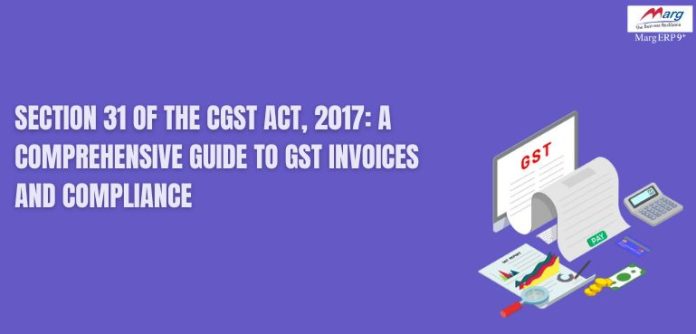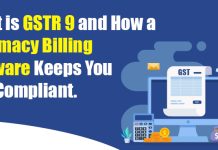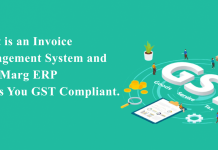Section 31 of the Central Goods and Services Tax (CGST) Act, 2017, outlines the requirements for issuing tax invoices, a fundamental aspect of the Goods and Services Tax (GST) framework in India. A tax invoice serves as a legal document evidencing the supply of goods or services and is essential for the recipient to claim Input Tax Credit (ITC).
Understanding the provisions of Section 31 is crucial for businesses to ensure compliance and avoid potential penalties. A GST billing software like Marg ERP offers a tax compliant solution that keeps your business growth ready. Try now to uncomplicate tax compliance.
What are the Key Provisions of Section 31 of the CGST Act, 2017?
Registered business entities must understand following provisions of Section 31 of the CGST Act, 2017 to enjoy seamless compliance and accounting.
1) Issuance of Tax Invoice for Supply of Goods (Section 31(1))
A registered business entity supplying taxable goods must issue a tax invoice for a GST compliant billing and accounting.
- Before or at the time of removal of goods, if the supply involves movement.
- Before or at the time of delivery or making goods available to the recipient, in other cases.
The tax invoice should include;
- Description, quantity, and value of goods.
- Tax charged thereon.
- Other particulars as prescribed.
2) Issuance of Tax Invoice for Supply of Services (Section 31 (2))
A registered business supplying taxable services must issue a tax invoice and a billing software is a smarter way to manage tax-compliant invoicing.
- Before or after the provision of service but within a prescribed period.
The tax invoice should comprise:
- Description and value of services.
- Tax charged thereon.
- Other particulars as prescribed.
3) Supplementary Invoices, Debit Notes, and Credit Notes (Section 31 (3))
In case of adjustments to the original invoice, supplementary invoices, debit notes, or credit notes should be issued, specifying:
- The original invoice details.
- The nature and value of the adjustment.
- Tax implications of the adjustment.
4) Special Cases for Interstate Supplies (Section 31 (4))
For interstate supplies, the invoice should include:
- The place of supply.
- GSTIN of the recipient.
- Other details as prescribed.
5) Bill of Supply in Certain Cases (Section 31 (5))
In specific cases, a bill of supply can replace a tax invoice:
- Exempted Goods or Services: Supplies that are exempt from GST.
- Composition Scheme: Suppliers under the composition scheme.
- Non-taxable Supplies: Supplies that are not subject to tax.
6) Export of Goods and Services (Section 31 (6))
For exports, the invoice should include:
- The words “Export” or “Export Invoice”.
- GSTIN of the exporter.
- Other particulars as prescribed.
When to Issue Tax Invoice: A Summarised View.
| Scenario | Invoice Type | Time of Issue |
| Supply of Goods (Movement) | Tax Invoice | Before or at the Time of Removal |
| Supply of Goods (No Movement) | Tax Invoice | Before or at the Time of Delivery |
| Supply of Services | Tax Invoice | Before or After Provision of Service |
| Interstate Supply | Tax Invoice | Before or At The Time of Supply |
| Exempted Goods/Services | Bill of Supply | At the Time of Supply |
| Composition Scheme | Bill of Supply | At the Time of Supply |
| Export of Goods/Services | Export Invoice | Before or At The Time of Supply |
What are the Mandatory Details in a Tax Invoice?
- According to Rule 46 of the CGST Rules, 2017, a tax invoice must contain:
- Name, address, and GSTIN of the supplier.
- Consecutive serial number.
- Date of issue.
- Name, address, and GSTIN of the recipient (if registered).
- HSN code of goods or SAC code of services.
- Description, quantity, and value of goods or services.
- Taxable value and tax charged (CGST, SGST, IGST).
- Place of supply and name of the state.
- Signature of the supplier or authorized representative.
Impact of GST 2.0 (22nd September 2025) on Section 31 of the CGST Act, 2017
| Category/Aspect | Pre GST 2.0 (GST 2017) | Post GST 2.0 (September, 2025) |
| Invoice Format | Standardised but varied by category and sectors | Digital invoicing mandatory with unified HSN/SAC codes |
| Time of Supply | Goods: Removal and Delivery Services: Invoice Date | Goods: Removal and Delivery Services: Invoice Date/Payment Date |
| Input Tax Credit | According to the Supplier’s Declaration | Invoice Matching, Reversal if Supplier Defaults |
| E-invoicing | Voluntary for Large Taxpayers | Mandatory for Turnover Over 5 Crores |
GST Billing Software like Marg ERP ensure timely invoicing and tax compliance with automated reminders, updated tax rates, and more.
Why Compliance is Necessary for Every Business?
Business can suffer following consequences in the event of non-compliance within Section 31 and a top billing software with updated system help you stay compliant and ready.
- Denial of Input Tax Credit (ITC) to the recipient.
- Penalties and interest charges.
- Legal scrutiny and audits.
Therefore, adhering to the provisions of Section 31 is essential for smooth business operations and tax compliance.
Conclusion
Section 31 of the CGST Act is pivotal in ensuring transparency and accountability in the GST system. An advanced and modern billing software, a thorough understanding and adhering to its provisions, businesses can maintain compliance, facilitate smooth operations, and foster trust with their clients and tax authorities. Explore Marg ERP, the best GST billing software in India, and stay tax compliant and future ready always.
Frequently Asked Questions
What is a tax invoice under GST?
A tax invoice is a document issued by a registered supplier to the recipient, detailing the supply of goods or services, and is essential for claiming Input Tax Credit. Make your experience seamless with an all-inclusive GST billing software like Marg ERP and never miss a deadline.
When should a tax invoice be issued for the supply of goods?
For goods involving movement, the invoice should be issued before or at the time of removal. For goods without movement, it should be issued before or at the time of delivery.
Can a bill of supply replace a tax invoice?
Yes, in cases of exempted goods/services, composition scheme, or non-taxable supplies, a bill of supply can replace a tax invoice.
What are the mandatory details in a tax invoice?
Mandatory details include the supplier’s and recipient’s name and GSTIN, invoice number, date of issue, description and value of goods/services, tax charged, and place of supply.
What are the consequences of not issuing a tax invoice?
Failure to issue a tax invoice can result in the denial of Input Tax Credit, penalties, interest charges, and legal consequences.




















